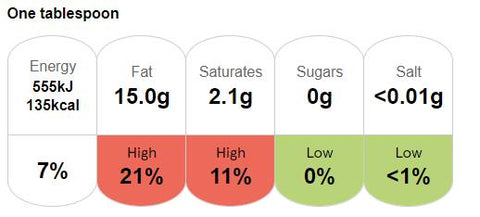How To Lose Weight Without Counting Calories
June 07, 2023

Without question, the fundamental principle to losing weight is to be in a negative energy balance. Commonly referred to as the calorie deficit, it means that we need to be eating less than we burn on a daily basis to lose weight.
The calorie deficit is the underlying principle in all weight loss programs. Keto, intermittent fasting, Atkins diet, carb restriction – the reason they work is because you’re eating in a calorie deficit, not for any other reason no matter what the marketing pushes in your face.
But the majority of us don’t want to follow one of these craze diets, we’d much rather continue eating the foods we enjoy, and eat when we want. And we can; we just need to eat in a calorie deficit.
But don’t worry, counting calories is not the only way to implement a calorie deficit. Not everyone gets on with the idea of tracking calories, some people believe it can introduce negative eating habits and others simply don’t have the time or don’t like the regimental aspect of recording everything you eat – and that’s fine.
The good news is that we can most definitely still lose weight without counting calories. This article discusses the different strategies we can use to lose weight without the burden of recording everything that goes into our stomachs.
| Table of Contents |
| Weight loss basics |
| Focus on protein |
| Minimise liquid calories |
| Choose low calorie density foods |
| 80/20 Diet |
| Be conscious of fat intake |
| Workout regularly |
Weight loss basics
We’ll keep this simple. During the day, we burn calories. We burn calories while we’re resting, which is known as our metabolic rate, and we burn calories when moving/exercising – the sum of both is known as our daily calorie expenditure.
To lose weight, we need to consume fewer calories than we’re burning. A daily calorie deficit of between 250-500 is advisable, which should result in weight loss of between 0.5-1% of body weight.
We can do this in one of two ways. We can either eat less or burn more.
Option 1 – We eat less. Say we’re burning 2500 calories a day to begin with, to lose weight we will need to drop this to 2000-2250.
Option 2 – It can be difficult to eat less. We may already be eating a low-calorie diet so restricting it further is not possible, or you may be like us and love our food too much! Either way, if we don’t want to drop our calories, we can look at the other end of the equation and increase the calories we burn.
Using the example from above, we may currently be eating 2500 calories. For us to lose weight without cutting back the calories we need to increase our daily calorie expenditure to 2750-3000.
The best way to do this is by working out. Not only do we get to burn more calories, but working out brings in countless positive benefits, including dramatically improving our body composition.
Rather than focusing on overall ‘weight’ loss, we want to be focusing on ‘fat’ loss. If we simply aim to lose ‘weight’ then we’re essentially going to look like a smaller version of our previous selves.
Whereas if we focus on losing ‘Fat’ then we’re going to improve our body composition and work towards the strong, toned look we’ve dreamed of.
Now we know how we plan to lose weight, let's look at different ways we can implement it.
Focus on protein
Out of the 3 macronutrients: protein, fat, and carbohydrates; protein increases satiety more so than the others leading to reduced hunger (1). This reduced hunger can lead to a decreased energy intake (2), which can help us stick to our calorie deficit.
A study (3) conducted with 19 individuals confirms this theory. The study looked at the effects of a high protein diet on energy intake and fat mass. The results show that when not sticking to a calorie counted diet, high protein intake resulted in an average decrease of 400 calories per day which resulted in a drop of 3.7kg of fat mass over a 12 week period – pretty solid results!
Not only does protein help us eat less, but it can also help us burn more. Studies (4) have shown that protein has a larger effect on our metabolism post-consumption than any of the other macronutrients. This is because the body requires more energy to make use of the protein than it does for both carbohydrates and fats.
It is protein that is responsible for the growth and repair of all body cells, including muscle cells. To keep hold of the muscle we have built, we need to ensure we’re eating enough protein each day. We recommend eating 1.8g-2.4g of protein per kg of body weight during our fat loss program to maximise muscle retention.
As we’re not counting calories, knowing whether we’re getting enough protein may be difficult. We therefore recommend eating a high-quality protein source with each meal and supplementing with a protein shake to give us the best chances of getting enough protein each day.
Minimise Liquid Calories
Liquid calories can soon stack up without you noticing and can be the difference between losing weight or not. Take a standard bottle of coke for example, a 500ml bottle has a staggering 210 calories.

Not a fan of fizzy drinks, maybe you’d prefer a coffee instead?

As you can see, an average coffee has got 180 calories in it – unexpected ay.
Or maybe you don’t drink coke or coffee and normally opt for a ‘healthier option’, a smoothie perhaps?

Even you’re typical smoothie is packed full of calories, and most of these calories come from sugar.
The thing with sugar is that it has almost no satiating effect, meaning although there are a fair few calories in these drinks, they’re not going to have an effect on hunger levels. What normally happens is that our daily calorie intake increases when we drink sugary drinks (5).
We’re not saying you shouldn’t drink these things, it’s just that we need to be mindful that these drinks aren’t calorie free.
These additional calories can prevent the all-important ‘Calorie deficit’ and could be the difference between losing weight and not losing weight – it may be time to re-think those drink choices, or at least appreciate how many calories they have in them so you can compromise on another area of the diet.
But, drinks are only half of the picture; we also need to be aware of the calories in cooking oils and sauces.
Take olive oil for example, a common cooking oil that nearly every household has in their cupboard. A single tablespoon of this oil contains a staggering 135 calories!

Mayonnaise is another culprit. A 15-gram serving contains 97 calories.

Again, we’re not saying you should cut these out of your diet, but just be aware that oils and sauces tend to be heavy in calories, so we should try and limit these where possible.
Chose low-calorie density foods
Another method to help with losing weight is to opt for low-calorie density foods over alternative high-calorie density foods.
Foods such as fruits and vegetables are considered to have low-calorie density whereas fatty foods and processed foods are considered high density. This is because gram for gram, they contain fewer calories.
Studies have shown that opting for low-calorie choices can help with weight loss. A study (6) including 97 women took place over a year to see how eating low-calorie density foods such as fruits and vegetables impacted on weight loss. Results show that those who consciously ate more of these foods lost more weight than those who didn’t. They also reported less hunger which is ideal for any calorie restricted diet.
This is likely due to those who ate more of the lower-calorie foods ended up eating fewer calories daily. In fact, a 2019 study found that those eating high-calorie density food over lower-calorie density foods ended up eating twice as many calories daily to feel satisfied.
Reducing our calorie intake is nearly always going to make us feel hungry. To counteract this, consciously eating more low-calorie density foods will prevent us from overeating and keep us in the calorie deficit required to lose weight.
Additionally, fruit and vegetables are great sources of vitamins and minerals, and eating more of these is always a good idea for overall health. They’re also high in fibre which has also been shown (6) to aid with weight loss – it’s a win, win!
80/20 Diet
Arguably the most important element when dieting is adherence. Losing weight doesn’t happen overnight, it’s the result of weeks/months of being in a calorie deficit.
Yes, you could design a diet plan where you’re eating a salad 4 times a day and snacking on avocado. And yes, you’d probably lose weight – but chances of you sticking to the plan for any sort of time to notice any progress is slim.
A much better approach would be to design a plan that you’re going to stick to. And this is done by not completely throwing out the foods you most enjoy.
Introducing the 80/20 approach.
Let us explain. The 80/20 approach is where 80% of the time you’re eating healthy, natural foods; foods that haven’t been processed. And 20% of the time you get to relax a little and eat the foods you enjoy (but aren’t exactly the healthiest option).
By not completely cutting out the foods you enjoy, you’re more likely to stay on the wagon.
Be conscious of fat intake
As we discussed in the first few paragraphs, protein is the most satiating macronutrient. Fat is the least satiating (7).
Protein has 4 calories per gram.
Carbohydrates have 4 calories per gram.
And Fat has 9 calories per gram.
So fat has double the amount of calories per gram but is the least satiating, that there is a good enough reason to keep your fat intake under control to ensure you’re not preventing the calorie deficit.
Consider swapping out high fat meats for lower fat alternatives (ie. 15% beef for 5% beef) and other high fat foods (oily fish, nuts, dairy).
Workout Regularly
In our eyes, working out regularly is the best thing someone can do to lose weight. Not only will we burn calories which will help with the fat loss energy balance equation, but we’ll be able to build muscle and drastically improve our body composition.
Besides the positive benefits working out brings to our body composition, working out regularly brings heaps of benefits including: reducing the risk of disease, increasing energy levels, improving mental health, improving bone health, promoting better sleep, and improving confidence.
Final Thoughts
Although counting calories is a proven way to lose weight, it’s not the only way. The reason why calorie counting works is because we can ensure we’re in the calorie deficit required to lose weight.
Utilising the methods discussed in this article will help us to create the same calorie deficit required to lose weight without the need to enter everything we eat into a diet log.
Give them a try today and let us know how you get on!






Thomas D
Author
Thomas is a dedicated fitness enthusiast with over 12 years of experience in the gym. As a level 2 qualified gym instructor, he combines his passion for working out and nutrition to help others achieve their fitness goals. Thomas stays up to date with the latest fitness research and follows the work of top experts in the field. With a balance of textbook knowledge and real-life experience, he provides practical guidance to help others reach their full potential.